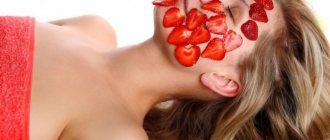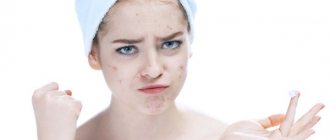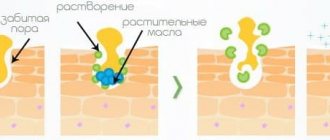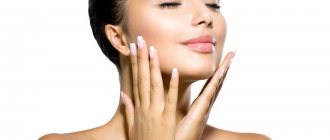The article was prepared by a specialist for informational purposes only. We urge you not to self-medicate. When the first symptoms appear, consult a doctor.
Human skin is a complex organ that protects the body from many damages, takes part in breathing, in the process of thermoregulation, in metabolic reactions, etc. The skin of the face is especially vulnerable to external influences, since it most often remains unprotected.
Improper care, age-related changes in the body, disturbances in the functioning of the sebaceous glands, exposure to the sun, wind, frost, hormonal imbalances, various diseases - all this can cause irritation of the skin on the face. There are many external and internal factors that influence the condition of facial skin. By focusing on the main reasons why irritation occurs, you can prevent this problem from occurring or eliminate it promptly and quickly. After all, skin irritation is often not only a cosmetic defect, but also a sign of trouble in the body.
Redness on the face - why it appears
Brief redness on the face is usually not a sign of health problems. In this way, healthy skin reacts to temperature changes, physical activity, stress, alcohol consumption and other unusual situations. The main thing is that a healthy body quickly copes with this and after a few minutes the complexion returns to normal.
If red spots on the face appear regardless of the emotional state or external factors, then you should think about undergoing a full examination by a doctor.
Common causes of redness on the face:
- The body's reaction to citrus fruits (lemons, oranges, tangerines, etc.);
- Excessive tanning without the use of protection;
- Eating sweets or foods high in sugar;
- Reaction to cosmetics or hygiene products.
However, sometimes red spots appear on the face, seemingly for no apparent reason. In this case, it is important to visit a doctor and identify the exact cause of their occurrence. It is dangerous to take any measures without consulting a professional.
In addition to the above reasons, redness on the face can also be a reaction to the following irritants:
- Allergic reactions. An allergy can appear to anything and at any age, even if it has never existed before.
- Inflammation. Facial skin is delicate and sensitive, so damage to it can cause inflammation.
- Food. Too sweet, salty or simply fried can cause a reaction on the face.
- Vascular reaction. Vessels may dilate after physical exertion, alcohol, severe coughing or laughter, or a sudden change in temperature (for example, in a bathhouse, sauna).
In most cases, redness on the face is not a serious pathology and can be easily treated.
Rosacea
Gastritis
Hepatitis
Ulcer
13665 January 20
IMPORTANT!
The information in this section cannot be used for self-diagnosis and self-treatment.
In case of pain or other exacerbation of the disease, diagnostic tests should be prescribed only by the attending physician. To make a diagnosis and properly prescribe treatment, you should contact your doctor. Rosacea: causes, symptoms, diagnosis and treatment methods.
Definition
Rosacea is a chronic skin disease characterized by erythema (redness), the presence of papulopustular elements (nodules), fimas (lumpy bumps) and eye damage.
Causes of rosacea
Rosacea most often develops in women aged 30-50 years. Men get sick less often, but more severely. This disease is common in people with white skin and combines genetic predisposition and trigger factors.
The causes of rosacea are not fully understood. The occurrence of the disease can be caused by vascular pathology, immunological disorders, diseases of the gastrointestinal tract, and changes in the endocrine system.
Triggers that initiate this process include severe stress, inflammatory diseases or exposure to temperatures, including sudden changes from hot to cold and vice versa.
Pathologies of the gastrointestinal tract are most likely not leading in the development of the disease.
However, patients with rosacea often have concomitant gastrointestinal pathologies: gastritis, gastric and duodenal ulcers, chronic inflammatory bowel diseases, chronic hepatitis; Helicobacter pylori
is often found in the stomach .
Sex hormones can influence the state of microcirculation (blood movement through small vessels) of the skin and the development of immune inflammation. Their imbalance is one of the possible causes of the development of the disease.
Demodex mites
usually present on the skin of a healthy person. However, there is a significant increase in the number in patients with rosacea.
Classification of the disease
Depending on the nature of the skin manifestations, several subtypes of rosacea are distinguished.
- erythematotelangiectatic;
- papulopustular;
- phymatous, or hypertrophic;
- ocular or ophthalmic rosacea;
- granulomatous.
It is important to note that the incidence of rosacea with erythema in the central part of the face - erythematotelangiectatic rosacea (subtype 1) - is 4 times higher compared to papulopustular rosacea (subtype 2).
Phymatous changes, according to experts, occur in 1-4% of patients with rosacea and more often in men. However, in routine practice, most patients are diagnosed with several subtypes of rosacea at the same time, which must be taken into account when choosing a therapeutic approach aimed at treating the manifestations that the patient has, and not just the subtype. Depending on the severity of the clinical symptoms of the subtype, degrees of severity are distinguished: mild, moderate-severe and severe.
Symptoms of rosacea
The disease has a chronic course with periods of exacerbation and remission.
With the erythematotelangiectatic subtype of rosacea, the patient notes redness of the skin of the face, and less often of the neck and chest. At first, redness appears only in response to provoking factors, but as the disease develops it becomes persistent. The patient is concerned about a burning sensation and tingling sensation in the area of erythema, dryness, and a feeling of tightness of the skin. There is increased skin sensitivity to topical medications, skin care products, sunscreens and ultraviolet radiation.
With the papulopustular subtype, against the background of persistent erythema, randomly located bright pink papules—nodules or tubercles measuring 3–5 mm—appear in the central part of the face. Subsequently, cavity elements are formed - pustules with sterile contents. Patients complain of burning, tingling at the site of the rash. Peeling is usually absent.
With the phymatous or hypertrophic subtype, in addition to persistent erythema, multiple telangiectasias, papules and pustules, there is thickening of the skin, uneven tuberosity and the formation of pineal formations - phym. The skin of the nose is affected, less often - the forehead, chin, ears, eyelids.
With phymatous lesions of the nose, difficulty breathing may occur.
With ophthalmic rosacea, redness, burning and itching of the eyes are observed; sensation of a foreign body and veils before the eyes; photosensitivity, up to photophobia. Ophthalmic rosacea is often diagnosed in the presence of skin symptoms, but in some patients, eye symptoms appear before skin symptoms, making diagnosis difficult.
In granulomatous rosacea, there is little redness of the facial skin, but yellow, brown or red papules are present, which can subsequently lead to scarring. Patients are concerned about dry facial skin and a feeling of tightness.
Diagnosis of rosacea
The diagnosis is usually made based on the results of a physical examination and analysis of the patient's complaints. Additional laboratory and instrumental studies are usually not required.
In difficult situations when making a diagnosis, a skin biopsy may be performed to rule out other skin diseases such as lupus or sarcoidosis.
How to remove redness on the face
How to get rid of redness on your face by following a few simple rules:
- Proper nutrition. What a person eats is immediately reflected on his skin. You should not abuse coffee and unhealthy fatty foods; it is better to switch to natural herbal teas. Also, do not eat food too hot. This increases sweating, which is harmful to your facial skin.
- The right tan. Even with a simple walk outside in the summer, you should not forget about sunscreen. Excessive sun exposure is harmful to all skin.
- Strengthening blood vessels. The vessels on the face should always be in good shape. To strengthen blood vessels, you can use specialized gels, for example Escin.
- The right cosmetics. It is important to use anti-redness cream on the face and cosmetics and face wash products that are compatible with your skin type.
It is important to properly cleanse the skin, tone and moisturize. The main thing is not to use aggressive components, silicones and fragrances - so as not to provoke facial irritation.
Products that can be considered as care products for sensitive skin include:
1. Cleansing - Cleansing foam with plant enzymes ResedaOdor. The product has a soft structure and does not contain aggressive components, alcohol, flavors or dyes. Contains plant enzymes from pomegranate and pumpkin. They act as a soft natural peeling. Without tightening or drying out the skin.
Foam with plant enzymes ResedaOdor, cleansing
2. Toning – ResedaOdor Restoring skin toner, 250 ml. Contains a combination of northern plant extracts. Does not contain alcohol, dyes or flavors. Suitable for dry, normal and sensitive skin.
ResedaOdor Restoring skin toner
3. Moisturizing - ResedaOdor rich cream for deep skin hydration. The cream is specially created to deeply moisturize the skin. low molecular weight hyaluronic acid acts in the deep layers of the epidermis. Relieves irritation, restores the hydrolipid layer and protects the skin from external influences. Also contains spf 6.
ResedaOdor cream, rich, deep skin hydration
How to get rid of skin irritation on the face?
The process of getting rid of irritation on the face depends entirely on what caused the unwanted reaction:
Relieving irritation caused by allergies
To eliminate the irritation caused by an allergic reaction, it is necessary to determine what exactly acts as an allergen. Then avoid any contact with the irritating substance as much as possible. It is possible to take antihistamines (Zyrtec, Zodak, Erius, Telfast, etc.).
When you cannot cope with an allergic reaction on your own, you need to contact a dermatologist and allergist. After carrying out specific tests, it is most often possible to identify the allergen and eliminate it from your life as much as possible.
To treat contact dermatitis, it is possible to use ointments with corticosteroids (Advantan, Lokoid, etc.), but only a doctor can recommend them.
Find out more: Antihistamines 1st, 2nd and 3rd generation
Relieves irritation caused by weather conditions
To prevent skin irritation due to exposure to frosty air and wind, you should protect your face with a scarf. It is recommended to use special protective creams in winter. They are applied to clean facial skin at least an hour before leaving home.
It would be good if the cream contains the following components:
- Hyaluronic acid, plant bioenzymes, lecithin (promotes skin hydration).
- Sesame oil, coconut oil and grape seed oil (prevent moisture evaporation).
- Extracts of plants and fruits (aloe, chamomile, avocado, cucumber, papaya, etc.).
- Vitamin B5, which not only nourishes but also moisturizes the skin.
If you plan to use cosmetics, you should choose special creams intended for application under makeup. You should remember to protect your skin from sunlight. Even winter cream should contain UV filters. Protective creams are selected depending on the skin type, otherwise they can cause harm.
It is important to do an allergy test before using any new product. To do this, the cream is applied to the elbow and left overnight. If there is no irritation in the morning, then the cream can be used without fear.
Elimination of facial skin irritation caused by hormonal imbalances
To ensure that your skin is minimally susceptible to irritation during menopause, you should pay special attention to it.
Derma care should have the following features:
- Each skin cleansing process should be accompanied by additional moisturizing.
- Facial cleansers must contain moisturizing ingredients.
- Instead of soap, you should use facial foams and gels.
- To exfoliate your skin, you should choose products with alpha hydroxy acids (AHAs).
In addition, a woman should drink enough water per day, eat a balanced diet and give up bad habits. If, in addition to irritation and dry skin, a woman during menopause is also bothered by other manifestations of hormonal imbalance (sweating, fever, hot flashes, etc.), then she should consult a gynecologist. Your doctor may recommend taking hormonal medications or other medications designed to improve your well-being during menopause.
As for facial skin irritation during pregnancy, it most often goes away after the baby is born. You should not take any medications, even completely natural ones, without your doctor’s permission. To reduce skin irritation, you can use ice cubes. To do this, boiled water is frozen, and then in the morning and evening after the cleansing procedure, they wipe the skin with it.
Even during pregnancy, you can safely use a mask with cottage cheese and kefir (you should mix 2 tablespoons of each product), or a mask based on cucumber pulp and chopped parsley. Any of the masks is applied to the face for 15 minutes, after which it is washed off with warm water.
Pregnant women should remember that if irritation on the face is accompanied by a general feeling of unwellness, then they should not hesitate to consult a doctor.
If skin irritation appears in adolescents during puberty, this requires special attention. Your diet and daily routine should be adjusted. If this does not help, then you can use special ointments, including: Skinoren gel, Salicylic ointment, Retinoic ointment, Zinc ointment, etc. Each of the listed products should be applied only to thoroughly cleansed and dry skin. The drug for external use Zerkalin has proven itself well, which can be used both in adults and in adolescence. After consultation with a dermatologist, drug correction of acne and other skin irritations in adolescence is possible.
In the case when skin irritation appears due to hormonal imbalances caused by dysfunction of the adrenal glands, ovaries or thyroid glands, treatment is carried out exclusively by a doctor. It will completely depend on what kind of disease the person has.
Find out more: Hormonal imbalance in women and men, causes and symptoms, what to do?
Elimination of skin irritation due to vitamin deficiency
If irritation on the skin of the face is caused by a lack of vitamins, then their deficiency must be replenished. A person should adjust their diet and include more fresh vegetables and fruits. The menu should be designed in such a way that at the same time the body receives products that do not interfere with, but promote mutual absorption.
In addition to proper nutrition, in case of vitamin deficiency it is necessary to take vitamin complexes (Undevit, Triovit, Centrum, Pikovit, Supradin, etc.). However, they must be prescribed by a doctor; it is he who determines the timing of taking vitamins and selects a specific drug. It should be remembered that an excess of vitamins in the body also negatively affects the condition of facial skin and health in general, as does their deficiency.
Elimination of skin irritation due to dysbacteriosis
To get rid of irritation on the skin of the face due to dysbacteriosis, it is necessary to find out the cause that led to the disruption of the intestinal microflora and eliminate it.
General recommendations aimed at getting rid of dysbiosis are:
- Optimization of the power supply scheme.
- Taking vitamins.
- Taking probiotic medications (Linex, Rioflora Immuno, Bificol, Bifiform, etc.).
- In severe cases (when dysbiosis is caused by intestinal diseases), antibiotics, intestinal antiseptics, and bacteriophages are prescribed.
After completing a course of treatment for dysbiosis, you will be able to get rid of skin problems. If the cause of irritation is inflammatory (colitis, infections, etc.) and other intestinal diseases (adhesive disease, intestinal polyps, etc.), then specific treatment is carried out.
Elimination of facial skin irritation due to demodicosis
It is impossible to completely get rid of demodicosis, however, achieving stable remission is quite possible. The use of antiparasitic drugs is not always justified, since taking such drugs will take too long, which is due to the life cycle of the tick. Treatment of demodicosis is possible with Tinidazole or Metronidazole, but in order to achieve a high concentration of these drugs in the skin, they will need to be taken for a long time, which can negatively affect a person’s health.
Therefore, for deep lesions, medications prepared in a pharmacy according to a doctor’s prescription are used. It is also possible to apply topical gel preparations with Metronidazole. Cosmetological procedures have a beneficial effect on the condition of the skin with demodicosis: microdermabrasion, electrophoresis with moisturizers, professional peelings and non-hardware facial cleansing.
During treatment, the use of decorative cosmetics is prohibited; daily change of bed linen, washing and carefully ironing pillowcases are necessary. It is possible to use medicinal cosmetics. You should be prepared for the fact that the process of getting rid of a tick is very long and labor-intensive.
Systemic lupus erythematosus treatment and skin care
Treatment of lupus erythematosus is within the competence of the doctor; self-administration of any medications is unacceptable. Patients are prescribed hormonal ointments, cytostatics, and NSAID injections.
A very important recommendation for people with systemic lupus erythematosus is to avoid exposure to direct sunlight. Naturally, it is impossible to completely avoid sun exposure to the skin, so you should protect it with creams with UV filters.
In particularly severe cases, immunosuppressive stem cell therapy is performed.
Elimination of irritation on facial skin due to burns
Any sunburn should not be left untreated, no matter how intense it is. First of all, you need to stop the sun from getting on your skin; to do this, you need to hide in a cool room or in the shade. Place a clean cloth (it is best to use a sterile bandage) soaked in cool water on the damaged area. Such compresses should be changed every quarter of an hour.
Further treatment of a skin burn comes down to taking vitamins (A, C, E), taking NSAIDs (to eliminate pain), and taking antihistamines (to reduce burning and itching). Thus, taking Paracetamol or Ibuprofen can reduce pain, Loratadine, Fenkarol, Tavegil, etc. can help relieve swelling and reduce itching of the skin.
To accelerate the regeneration of the skin, various creams, sprays, ointments are used: Dexpanthenol, Elovera, Vinilin, Sea buckthorn oil, Zinc ointment, Actovegin, etc.
Elimination of skin irritation due to fungal infection
A fungal infection should be treated by a dermatologist. He determines the type of pathogenic microorganism and, in accordance with this, prescribes medications. The patient will be recommended to use antifungal ointments, including: Clotrimazole, Miconet, Econazole, etc. It is possible to take antifungals orally. During treatment, it is recommended to stop using decorative cosmetics and adhere to a diet with an emphasis on plant and dairy products.
How to remove irritation on your face
The cause of redness is irritation, which is a constant companion of sensitive skin. For this type, it is important to constantly use a cream for skin irritation on the face. You can try several options and choose the most suitable one.
How to get rid of irritation on your face with daily care? When washing, the water should not be too cold or hot. The optimal water temperature will be approximately equal to body temperature – 36-40 degrees. It is important to apply the cream after each wash in the morning and evening.
As an additional care, we recommend using Monomolecule No. 17, which helps reduce irritation caused by: UV rays, immune reactions, exposure to external factors and mechanical stress. Affects the nervous system of the skin, improving its condition.
Monomolecule No. 17 anti-stress for sensitive skin ResedaOdor
Sensitive skin is one of the main types, which is characterized by an excessive response to physical, chemical, and hormonal factors. Sensitive skin shows signs of irritation, redness, peeling, and rashes. This type requires agents that act on nerve endings and suppress the activity of substances that trigger inflammation.
Monomolecule No. 17 is an ideal assistant. It belongs to neurocosmetics. These are cosmetics whose ingredients are able to penetrate the stratum corneum and influence specific structures of the nervous system.
Ingredients
Water, Butylen glycol, Dextran, Palmitoyl-tripeptide-8.
Causes of skin irritation on the face
The main causes of skin irritation on the face:
Allergic reactions
Facial skin irritation often occurs as a result of exposure to allergens. They can act both internally and externally.
The main types of allergens are:
- Foods that a person eats (the most allergenic foods are considered to be: chocolate, bright red fruits and vegetables, seafood, nuts, eggs). Each person's body is unique and what causes an allergy in one may not cause any reaction in another.
- Household chemicals: cleaning powders, detergents, washing powders, etc.
- Cosmetics. This includes all kinds of creams, shower gels, powders, shadows, etc.
- Metals. Especially often, irritation occurs on the face due to wearing inappropriate jewelry. An allergic reaction may occur after the piercing procedure.
- Insect bites often cause allergic inflammation and lead to irritation. Sometimes insect bites can pose a direct threat to human life, especially if a lot of poison has entered the body.
- Taking medications.
The process of inflammation on the face due to exposure to allergens can occur as a type of contact dermatitis, when the irritant gets on the skin. As a result, a person experiences skin hyperemia, itching and peeling. The skin of the face becomes covered with blisters.
Sometimes irritation on the face occurs like urticaria. In this case, the reaction occurs instantly after contact with the allergen. Irritation is expressed in the form of redness and itchy swelling of the skin. As a rule, identifying the allergen in this case is easier.
Weather
Very often, irritation of the skin on the face occurs due to changing weather conditions. Low air temperatures, strong winds with rain and snow can provoke inflammation and peeling. An additional irritating factor are heating appliances that operate in the house during the cold season. They make the air dry, and this immediately affects the condition of the facial skin.
Hormonal imbalances and facial skin irritation
As they age, many women notice increased dryness of their skin, which becomes prone to irritation and inflammation. If a woman is over forty, then most likely this process is associated with changes in hormonal status due to the onset of menopause. Hormonal changes affect the functioning of the sebaceous glands, slowing them down. As a result, even minor impacts on the facial skin lead to irritation.
Hormonal imbalances in the body can be caused by pregnancy and puberty. While pregnant, women often develop flaky red spots on their faces, and during puberty, adolescent skin becomes more prone to irritation, which manifests itself in the form of acne. It is known that the level of hormones in a teenager can change several times a day; if we add to this factor poor nutrition and emotional stress, then skin irritation during puberty cannot be avoided.
The content of estrogen in the body, which has a direct effect on the condition of the skin, can change with diseases of the thyroid gland, inflammation of the ovaries, and pathologies of the adrenal glands. All problems in the body will certainly affect the condition of the skin and, first of all, the condition of the facial skin.
Diseases that cause irritation of the facial skin
Such diseases include:
- Avitaminosis. A lack of vitamins always leads to the fact that the condition of the facial skin worsens, and areas of irritation, inflammation and peeling appear on the dermis. With vitamin deficiency, no nourishing cream can help, since the problem will come from the inside. It is the face that suffers first, although it is possible that areas of irritation may appear on the palms and on the extensor surfaces of the elbows and knees. The skin reacts especially acutely to a deficiency of vitamin A, vitamin C, vitamin K, B vitamins, and vitamin E. The causes of vitamin deficiency may be hidden in poor nutrition, as well as in disruption of food absorption processes, for example, in intestinal diseases.
- Dysbacteriosis and intestinal diseases. Disturbance of the intestinal microflora, its inflammatory diseases, disruptions in the functioning of the gastrointestinal tract - all this can affect the condition of the facial skin. A lack of bacteria leads to the fact that food is not able to be fully absorbed. As a result, a person does not receive enough vitamins and minerals, he develops vitamin deficiency, which leads to irritation on the skin.
- Demodecosis. Irritation on the skin of the face may occur due to infection with eyelash mites. Very often, he chooses the eyelids, chin, nasolabial triangle, forehead and other parts of the face and head as his habitat. In the place where the tick begins to parasitize, an inflammatory reaction occurs, which is expressed in irritation, peeling of the skin, and the appearance of swollen and hyperemic areas. Applying cosmetics to the affected areas only increases irritation and provokes itching.
- Irritation on the skin of the face with lupus erythematosus. Lupus erythematosus is a serious autoimmune disease that causes a red rash on the nose and cheeks. The rash coalesces and often resembles a butterfly shape. At the same time, a person’s joints begin to ache, disturbances appear in the functioning of the kidneys, heart and blood vessels, gastrointestinal tract and nervous system.
- Facial skin irritation due to burns. Irritation on the skin of the face may occur due to a burn. It occurs after prolonged exposure to the sun, or after exposure to chemicals on the dermis. The skin turns red and begins to peel. The degree of irritation directly depends on how severe the burn was.
- Fungal infections. Irritation on the skin of the face may occur due to its damage by mycotic microorganisms. Most often, inflamed areas appear on the chin and neck. The surface of the skin begins to peel off and becomes covered with bumpy nodules. If a bacterial infection occurs, the pustules become yellow.
Improper skin care and other irritating factors
Despite the fact that there are many diseases that lead to irritation of the facial skin, most often the cause lies in improper care of the dermis.
Inflammation, peeling, redness, itching of the skin can occur for the following reasons:
- Incorrect selection of cosmetics that do not match a person’s skin type.
- Using alcohol lotions, tightening masks, alkaline soap for facial skin care.
- Washing with hard and highly chlorinated tap water.
- Improper shaving of the facial skin.
- Using aggressive peels, rough brushes and sponges, etc.
Other factors influencing the condition of the skin:
- Poor nutrition, including fatty, spicy and sweet foods, has a negative impact on the condition of facial skin.
- Non-compliance with drinking regime.
- Work in hot shops.
- Living in areas with unfavorable environmental conditions.
- Presence of bad habits (smoking, alcoholism).
- Taking certain medications.
- Cold dermatitis.
Face masks for redness and irritation of the skin
When answering the question of how to get rid of redness on the face, it is worth mentioning masks. Special masks are good for removing redness from the skin of the face. They must contain ascorbic acid, which is one of the most important vitamins for the body. In addition to vitamin C, the mask should contain moisturizers that will soothe the skin. One of the best moisturizing components is polymarin.
Dealing with redness on your face is easy. To do this, you must follow the rules of care and use cosmetics suitable for your specific skin.











